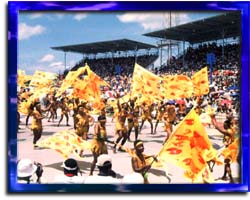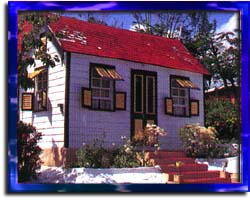
Crafts | Art Galleries | Artists | Museums | Music
Island Culture

Crafts | Art Galleries | Artists | Museums | Music
Island Culture
 Barbados' distinction of having remained under British rule from its first settlement in 1627 to its Independence on November 30, 1966, profoundly affected the culture. Because of this unbroken dominion, the stoic British influence courses through every day life and the infrastructure of the island.
Barbados' distinction of having remained under British rule from its first settlement in 1627 to its Independence on November 30, 1966, profoundly affected the culture. Because of this unbroken dominion, the stoic British influence courses through every day life and the infrastructure of the island. Yet the more flamboyant African sway pervades local life as well, and the blend of the two makes for an unmatched cultural disposition. This fusion ripples through all facets of daily living, from the foods and music to the house styles and street names. Even the language is affected, with Queen's English being the official 'language' while the colourful local dialect remains in common usage.
More than 70 per cent of the island's 260 000 people are direct descendents from the forced mass Africa migration of the late 1600s and 1700s-the slave trade. The island also has a peaceful blend of European (primarily British) settler blood with the Afro descendents, as well as small but vibrant Hindu (India), Arab (Lebanese and Syrian) and Jewish communities.
African influence is readily seen in the art, craft and literary works produced on the island, as well as many of the foods and figures of speech. Bajans are a quick-witted, fun-loving people and their gift for the double entendre or turn of phrase is most visible through calypso and literature. Local festivals, particularly the island's biggest national festival, Crop Over, reflect specific elements of Bajan life. The primary driving force of the economy and lifestyle was the sugar crop. It was the island's largest income-earner from the late 1600s until the late 1980s, and remains a powerful influence in both the lifestyle and the economy. Crop Over is a celebration of this agricultural mainstay. The other prime economic influence is, of course, the fishing industry and festivals hailing this trade are also held.
 The chattel house, a unique feature of Barbados, is one such product of the cultural side of sugar. Of necessity, plantation workers needed houses that were easily assembled and taken down so they could move from plantation to plantation. The chattel house is, in fact, perhaps the world's first true mobile home. Yet other architectural elements are distinctly British, such as the Jacobean style homes built here in the late 1600s. Barbados is the site of two of the three remaining examples of the house style in the Western Hemisphere.
The chattel house, a unique feature of Barbados, is one such product of the cultural side of sugar. Of necessity, plantation workers needed houses that were easily assembled and taken down so they could move from plantation to plantation. The chattel house is, in fact, perhaps the world's first true mobile home. Yet other architectural elements are distinctly British, such as the Jacobean style homes built here in the late 1600s. Barbados is the site of two of the three remaining examples of the house style in the Western Hemisphere.
The island's creative community is a vibrant one, with many artists producing work in all media, as well as a strong contingent of clothing designers and craftspeople. Drawing from the Africa, Caribbean and Anglo experience, much of the work here is distinctive and of high quality.